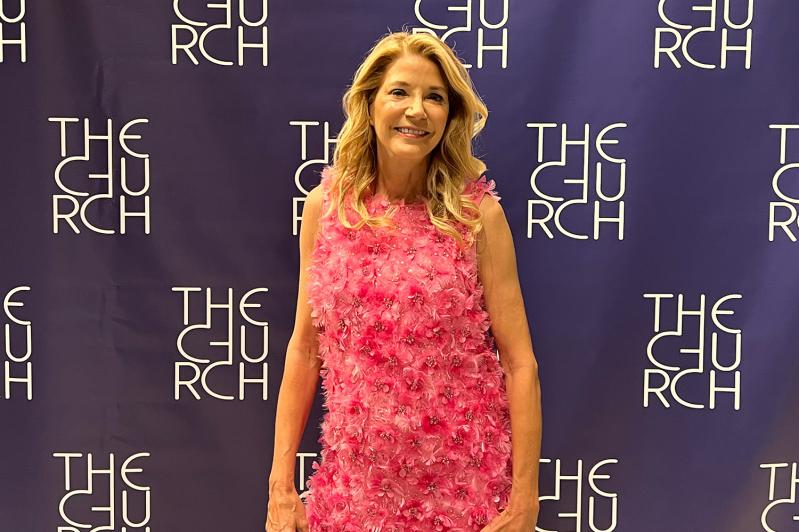And just like that, the O.G. Carrie Bradshaw was in the house. It was Saturday evening at The Church in Sag Harbor and the event was the arts organization's annual " 'ungala' that breaks with the conventions of 'rubber-chicken' fundraisers," according to The Church's website.
About 150 attendees ($600 a head for a seat downstairs, $400 in the mezzanine) were arranged around large tables, tucking into something tasty and mostly not listening to Sheri Pasquarella, The Church's executive director, who was politely paying homage to all the Native American tribes upon whose sacred land we've built McMansions, and also reminding the audience that America is suffering a crisis of loneliness.
Cosmopolitans -- the motif cocktail in the "Sex and the City" TV series -- were flying around the room by this point, everyone eager to move on and get to the real reason they were there: To watch Candace Bushnell in her one-woman performance titled "Is There Still Sex in the City?"
Ms. Bushnell famously penned her wildly popular "Sex and the City" column in The New York Observer from 1994 through 1996, full of confessional, witty, caustic, barely disguised stories about herself, her coterie of girlfriends, and their lives as ultimate party girls in the heady days of Manhattan of a certain era. The column became a smash-hit book, which became a multi-award-winning television series, then a film, then more films, several other books, a reboot of the original series, a podcast -- all in all, a game-changing cultural phenomenon.
Twenty-five years on from her sex column days, Ms. Bushnell has made visiting and revisiting her past a rich and financially rewarding experience. So, why stop now?
And, just like that, we were there in The Church, stranded in time as Ms. Bushnell rewound all the way to her childhood in Connecticut, arrival in New York City, Studio 54 nights, writing for Cosmopolitan magazine, The Observer, and so on. ("Another cosmo, please!")
It must be noted, however, that at 64, New York's most famous former sex columnist remains lavishly and perhaps calculatedly charming. On a makeshift stage at The Church, furnished with a pink couch and a couple of TV screens for visual reminders of "Sex and the City" highlights, Ms. Bushnell, a Sag Harbor resident, strutted about in a pink sequined Nicole Miller mini-dress that was as sparkling as her candor. Whippet-thin, blond and well coiffed, she cooly balanced on trademark stilettos; these were a pair of pink and crystal-studded (probably) Manolo Blahniks, the sort that would have rendered most elder stateswomen spatchcocked on the floor.
The "Is There Still Sex in the City?" solo show spawned from her 2019 semi-fictionalized memoir of the same title, which made a brief Off Broadway run and received largely positive reviews. It chronicled a period in her 50s, following her high-profile divorce from Charles Askegard, a ballet dancer 10 years her junior. Their decade-long marriage ended after she discovered his affair with a fellow dancer, a woman 15 years his junior.
So, she turned her literary focus to life as a newly single woman over 50, and in true form no subject is off the table: menopause, dating apps, Botox, sex, money, power, loneliness -- everything about gray, desiccated middle age and its myriad torments. In that sense, the material is fresh, and Ms. Bushnell delivers it in a bittersweet and amusing tone that's full of self-acceptance and wry resignation; now she sounds like fun!
However, this older, more compassionate version of the woman occupies perhaps only the last fifth of the show. To get there, we must go through all the blatantly secondhand details of her literary creations. To make it more fun, she instituted audience participation in the form of a "Real or Not Real?" quiz, asking attendees to guess whether certain memorable moments in the original "Sex and the City" TV series happened to Ms. Bushnell in real life.
"Did I end up with a shoe closet like Carrie Bradshaw in the second movie? Real or not real?" Ms. Bushnell asked, as an image of an Imelda Marcos-like display of shoes flickered on the TV screens.
"Reeeaal . . ." the audience droned, unsure.
"NOT real!" screamed Ms. Bushnell, the TV monitor now displaying the inside of a modest, though still impressive, closet with a stack of shoes. "The difference between Carrie Bradshaw's shoe closet and my shoe closet is that I paid for the shoes myself!"
Thank God for the cosmos.
What should have felt like dropping into a good conversation (and it did, briefly) felt more like listening to an obsessive tourist who only revisits her own past. But what does nostalgia tell you, anyway? To go back? We can't. And even if you could, would you really want to?
At best, Ms. Bushnell is, Manolos notwithstanding, a sort of sexagenarian torch-bearer of society's most irrelevant age group, someone who has discovered that tapping into nostalgia for lost certainty and lost beauty is perhaps the only way to remain a compelling cultural force.




